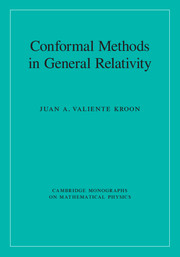Refine listing
Actions for selected content:
17002 results
Part IV - Applications
-
- Book:
- Conformal Methods in General Relativity
- Published online:
- 05 July 2016
- Print publication:
- 21 July 2016, pp 405-406
-
- Chapter
- Export citation
12 - Methods of the theory of hyperbolic differential equations
- from Part III - Methods of the theory of partial differential equations
-
- Book:
- Conformal Methods in General Relativity
- Published online:
- 05 July 2016
- Print publication:
- 21 July 2016, pp 294-330
-
- Chapter
- Export citation
10 - Asymptotics
- from Part II - General relativity and conformal geometry
-
- Book:
- Conformal Methods in General Relativity
- Published online:
- 05 July 2016
- Print publication:
- 21 July 2016, pp 222-244
-
- Chapter
- Export citation
Part III - Methods of the theory of partial differential equations
-
- Book:
- Conformal Methods in General Relativity
- Published online:
- 05 July 2016
- Print publication:
- 21 July 2016, pp 245-246
-
- Chapter
- Export citation
13 - Hyperbolic reductions
- from Part III - Methods of the theory of partial differential equations
-
- Book:
- Conformal Methods in General Relativity
- Published online:
- 05 July 2016
- Print publication:
- 21 July 2016, pp 331-389
-
- Chapter
- Export citation
11 - The conformal constraint equations
- from Part III - Methods of the theory of partial differential equations
-
- Book:
- Conformal Methods in General Relativity
- Published online:
- 05 July 2016
- Print publication:
- 21 July 2016, pp 247-293
-
- Chapter
- Export citation
1 - Introduction
-
- Book:
- Conformal Methods in General Relativity
- Published online:
- 05 July 2016
- Print publication:
- 21 July 2016, pp 1-24
-
- Chapter
- Export citation
References
-
- Book:
- Conformal Methods in General Relativity
- Published online:
- 05 July 2016
- Print publication:
- 21 July 2016, pp 569-586
-
- Chapter
- Export citation
6 - Conformal extensions of exact solutions
- from Part II - General relativity and conformal geometry
-
- Book:
- Conformal Methods in General Relativity
- Published online:
- 05 July 2016
- Print publication:
- 21 July 2016, pp 141-177
-
- Chapter
- Export citation
Acknowledgements
-
- Book:
- Conformal Methods in General Relativity
- Published online:
- 05 July 2016
- Print publication:
- 21 July 2016, pp xviii-xix
-
- Chapter
- Export citation
List of Symbols
-
- Book:
- Conformal Methods in General Relativity
- Published online:
- 05 July 2016
- Print publication:
- 21 July 2016, pp xx-xxx
-
- Chapter
- Export citation
9 - Matter models
- from Part II - General relativity and conformal geometry
-
- Book:
- Conformal Methods in General Relativity
- Published online:
- 05 July 2016
- Print publication:
- 21 July 2016, pp 211-221
-
- Chapter
- Export citation
19 - Static solutions
- from Part IV - Applications
-
- Book:
- Conformal Methods in General Relativity
- Published online:
- 05 July 2016
- Print publication:
- 21 July 2016, pp 504-526
-
- Chapter
- Export citation

Conformal Methods in General Relativity
-
- Published online:
- 05 July 2016
- Print publication:
- 21 July 2016
-
- Book
- Export citation
1 - Introduction
-
- Book:
- Glaciovolcanism on Earth and Mars
- Published online:
- 05 June 2016
- Print publication:
- 23 June 2016, pp 1-14
-
- Chapter
- Export citation
2 - Distribution of glaciovolcanism on Earth
-
- Book:
- Glaciovolcanism on Earth and Mars
- Published online:
- 05 June 2016
- Print publication:
- 23 June 2016, pp 15-56
-
- Chapter
- Export citation
12 - Felsic glaciovolcanic sequences
-
- Book:
- Glaciovolcanism on Earth and Mars
- Published online:
- 05 June 2016
- Print publication:
- 23 June 2016, pp 268-297
-
- Chapter
- Export citation
14 - Climate triggers for glaciovolcanism
-
- Book:
- Glaciovolcanism on Earth and Mars
- Published online:
- 05 June 2016
- Print publication:
- 23 June 2016, pp 342-349
-
- Chapter
- Export citation
15 - Hazards associated with glaciovolcanic eruptions
-
- Book:
- Glaciovolcanism on Earth and Mars
- Published online:
- 05 June 2016
- Print publication:
- 23 June 2016, pp 350-363
-
- Chapter
- Export citation
17 - Outstanding challenges and possibilities
-
- Book:
- Glaciovolcanism on Earth and Mars
- Published online:
- 05 June 2016
- Print publication:
- 23 June 2016, pp 392-399
-
- Chapter
- Export citation
